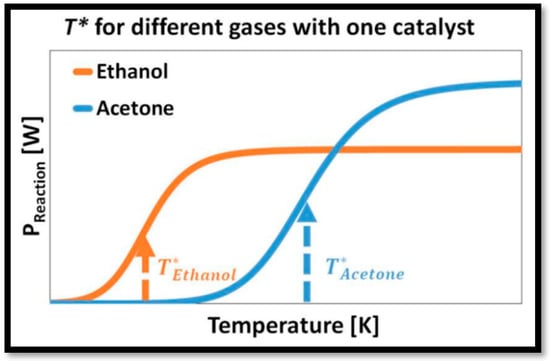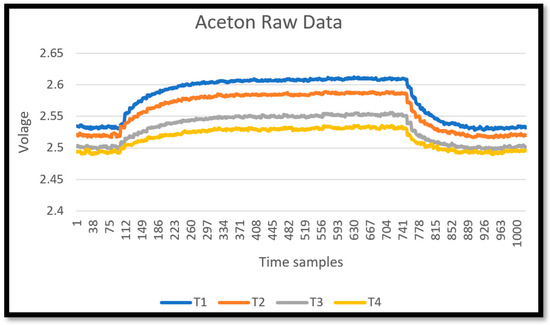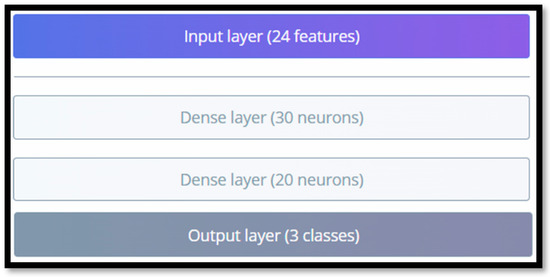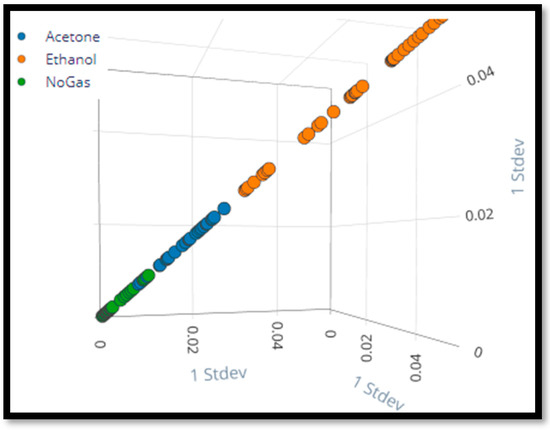Abstract
Embedded machine learning, TinyML, is a relatively new and fast-growing field of ML, enabling on-device sensor data analytics at low power requirements. This paper presents possible improvements to GMOS, a gas sensor, using TinyML technology. GMOS is a low-cost catalytic gas sensor, fabricated with the standard CMOS-SOI process, based on a suspended thermal transistor MOS (TMOS). Exothermic combustion reactions lead to temperature increases, which modify the suspended transistor’s (used as the sensing element) current-voltage characteristics. We were able to use GMOS measurements for gas classification (both for gas types, as well as concentration), resulting in high-proficiency gas detection at a low cost. Our preliminary results show great successes in the detection of ethanol and acetone gases. Moreover, we believe the method could be generalized to more gas types, concentrations, and gas mixes in future research.
Keywords:
TinyML; MEMS; gas sensor; SOI; MOS; data analytics; classification; machine learning; Edge Impulse; Arduino 1. Introduction
Since the 1980s, CMOS has remained the dominant microelectronics technology, for its well-established advantages. CMOS technology maintains the essential advantages of low power consumption, high noise tolerance, wide operating voltage, and operating temperature range. Furthermore, it rapidly and continuously improves the integration degree and intrinsic speed. Therefore, CMOS technology has become the most important technology in VLSI [1,2].
CMOS MEMS are micro-machined systems in which MEMS devices are integrated with CMOS circuitry on a single chip to enable miniaturization and performance improvement. With advancement of both CMOS and micromachining technologies, CMOS MEMS have also evolved tremendously in recent years [3,4,5].
In recent years, the need for mobile, low cost and low power gas sensors, has increased dramatically. Such gas sensors are needed for safety at homes and cars, monitoring air quality, well-being of people as well as industrial process control and precision agriculture.
The need to achieve digital scent technology, namely a technology to sense, transmit and receive scent-enabled digital media (such as motion pictures, video games, virtual reality, extended reality, and music) has been recognized as highly challenging.
This challenge has motivated the authors to focus on CMOS-MEMS technologies and the result is a new pellistor-like sensor dubbed GMOS. Since the first report in 2018, several papers describing the GMOS have been reported by the same group [6,7,8].
The main uniqueness of the GMOS is its ability to detect selectively different gases. Selectivity is achieved by measuring a fundamental physical property—the heat of exothermic reaction and ignition temperature, instead of measuring relative changes of resistance, as in Metal Oxide Semiconductor gas sensors. Thus, selectivity is enabled (see also Section 2).
In real-life applications, there is even a more challenging task: to measure selectively mixtures of gases. This study focuses on adding Tiny Edge Machine Learning to enable better analysis of gas mixtures.
The focus of this paper are the improvements we are adding to GMOS using TinyML technology for gas detection.
This paper is outlined as follows: Section 2 briefly describes the GMOS design and operation principles. Section 3 describes the Tiny Edge revolution, which makes the GMOS smarter by applying ML techniques based on the TinyML [9,10]. This paper presents the full system we built and describes our preliminary classification task. Section 4 provides our preliminary results, and last but not the least Section 5 states our conclusions, based on our results.
2. GMOS Design and Operational Principles
GMOS is a tiny combustion-type gas sensor, based on CMOS-SOI technology. The sensing element, a suspended MOFSET transistor, operates at subthreshold and therefore requires low power consumption. In contrast to MOX sensors, where the sensing element directly interacts with the gas, in GMOS the sensing element (the transistor) does not. Therefore, the sensor has potential for long-term stability.
Due to chemical reactions of gas combustion on a catalytic layer, the temperature change modifies I–V characteristics of the sensing element (transistor). GMOS is operated at the transition temperature between surface-controlled and diffusion-controlled transport, defined by the inflection point T*. Since the temperature region of the steep increase (transition region) is characteristic for a specific combustible gas and a certain catalyst (e.g., Pd, Pt), selectivity may be achieved. For different gases and the same catalyst, the transition region can be observed at different temperatures, as shown in Figure 1. Furthermore, an array of pixels with different catalytic layers, each operated in its T* temperature tailored for specific gases, allows specific detection of mixtures of gases [6,7,8].

Figure 1.
Comparison between Ethanol and Acetone gases. For the same catalyst, different T* are obtained.
3. TinyML for Gases Analysis
3.1. TinyML Presentation
Tiny Machine Learning (TinyML) is a relatively new and fast-growing field of research (due to modern hardware capabilities), which combines embedded systems and machine learning. The field integrates, reduces and optimizes machine learning applications that require “full-stack” (hardware, system, software, and applications) solutions, including machine learning architectures, techniques, tools, and it approaches the capability of performing on-device analytics at the very edge of the cloud [10]. Such technology enables ML applications on devices, which are power- and resource-constrained, and it is cheap—there is no need to send data to the cloud, which would add latency to the system.
3.2. Gas Detection Using GMOS and TinyML
We built a full system comprising a GMOS sensor, an Arduino-nano controller, and LED bulbs, as shown in Figure 2. The system operates on the GMOS output and analyzes it using a pre-trained neural network written to the Arduino controller. Finally, the neural network outputs a classification of the detected gas, and the verdict is displayed using the LED bulbs.

Figure 2.
A schematic depiction of the full system: An Arduino controller requests samples from GMOS over UART and lights a LED bulb according to its gas classification.
We focus on voltage measurements, where the sensing element’s voltage changes due to the chemical reaction. Contrary to the assumption that the difference between varied gases is the heat of exothermic reaction and ignition temperature, we did not look at the voltage graph of the GMOS output while igniting the gas. Rather, we looked at the voltage graph after it had stabilized, as shown in Figure 3. As a result, we could make use of additional information received by the sensor, which had not previously been used.

Figure 3.
A GMOS reaction in the presence of 100 PPM Acetone, sampled.
We should note that GMOS’s output is always relative to its initial output voltage (the reference voltage, the voltage before adding the gas to the sensor environment); therefore, the actual value of the voltage is probably of minor importance. Our samples were acquired with different reference voltages, and hence we started by pre-processing the raw data so that all samples would start from an initial voltage of 2.5 V.
In order to train the system, we used the Edge Impulse interface. We uploaded the data, after it was pre-processed, to the Edge Impulse application. We tried different features and network architectures to get a good separation between the classes we had defined.
The communication between the GMOS and the controller is carried out over a UART (Universal Asynchronous Receiver Transmitter) channel. The written code on the controller includes four main modules:
- Controller requests data from GMOS sensor.
- Raw data preprocessor.
- Feature extraction and inferencing (created using Edge Impulse tools).
- Output display.
The controller sends a request to the GMOS sensor to sample data. The current data size used as an input into the TinyML system is 1 × 24. When 24 samples are collected into the controller, the data is pre-processed by the controller in the same manner that samples were pre-processed during system training. Then, features are extracted from the raw data and transmitted as an input to the neural network. The network structure is shown in Figure 4.

Figure 4.
The fully connected neural network architecture includes an input layer (1 × 24), two hidden layers (30, 20 neurons) with ReLU activation functions, and an output layer (1 × 3) with a Softmax activation function.
The output vector size of the neural network is 1 × 3, where each value represents the probability of fitting to a corresponding class.
The training algorithm includes 80 epochs (number of training cycles) and the learning rate is 0.005.
We currently support two ways of displaying the classification results. We can display the output on a screen (using the Arduino platform). Additionally, to fit the full system into a tiny size, we also used LED bulbs, where each LED that lights up indicates a different classification identified by the system.
3.3. Proof of Concept Using Preliminary Classes
Our preliminary work focuses on Acetone and Ethanol gases. Our first objective was to classify the gases into one of the following classes:
- Ethanol—100 PPM
- Acetone—100 PPM
- None of the above (no gas was inserted)
The features that were chosen for this classification task allowed us to achieve a good linear separation between the classes.
One of those features, for example, was the standard deviation across time within the same temperature. As shown in Figure 5, the three classes may be separated.

Figure 5.
Standard deviation feature on a minibatch. Good separation was achieved (little overlap between Acetone and ‘No Gas’ classes).
4. Experiment and Results
The samples were taken from GMOS. They were divided into three subsets, which are the training, validation, and testing data sets. The raw data was preprocessed, and then features were extracted. We have checked the system performance on our test set, as shown in Figure 6, after training on our training and validation sets.

Figure 6.
The confusion matrix. 100% success was achieved on the test set.
We can see that the samples were perfectly classified. Additionally, the computational cost is quite low, as required, due to our current shallow neural network. The RAM usage is 1.7 K, the Flash usage is 19.8 K and the added latency to the system is 1 ms.
5. Conclusions
This paper demonstrated the possible improvements for GMOS using TinyML technology. We have built a full system which enables sampling data from GMOS as input and outputs gas detection at the other end. A preliminary classification model was created from GMOS measurements with a high score on our test set. We believe that this proof of concept shows that this system may help and improve the GMOS sensor. Future work may use more samples from a variety of gases and concentrations, as well as gas mixtures, in order to solve more complex classification tasks and hence make the GMOS sensor smarter with TinyML.
Author Contributions
Conceptualization, Y.N.; methodology, O.S.; software, A.K. and M.S.; validation, Y.N.; formal analysis, A.K. and M.S.; investigation, A.K. and M.S.; resources, Y.N.; data curation, D.S., T.B., S.S. and A.K.; writing—original draft preparation, A.K. and M.S.; writing—review and editing, Y.N.; visualization, A.K. and M.S.; supervision, Y.N. and O.S.; project administration, O.S.; funding acquisition, Y.N. All authors have read and agreed to the published version of the manuscript.
Funding
This research was funded by TODOS Technologies.
Institutional Review Board Statement
Not applicable.
Informed Consent Statement
Not applicable.
Data Availability Statement
Not applicable.
Acknowledgments
The authors would like to thank Edge Impulse Inc. and Arduino for their products.
Conflicts of Interest
The authors declare no conflict of interest.
References
- Yizhe, L. Advantages of CMOS Technology in Very Large Scale Integrated Circuits. In Proceedings of the 2021 2nd International Conference on Artificial Intelligence in Electronics Engineering (AIEE 2021), Phuket, Thailand, 15–17 January 2021. [Google Scholar]
- EETimes. MEMS Market to Top $22 Billion by 2018. Available online: https://www.eetimes.com/mems-market-to-top-22-billion-by-2018/ (accessed on 11 August 2013).
- Fedder, G.K.; Howe, R.T.; Tsu-Jae King, L.; Quevy, E.P. Technologies for cofabricating MEMS and electronics. Proc. IEEE 2008, 96, 306–322. [Google Scholar] [CrossRef]
- Baltes, H.; Paul, O.; Korvink, J.G.; Schneider, M.; Buhler, J.; Schneeberger, N.; Jaeggi, D.; Malcovati, P.; Hornung, M.; Hiberli, A.; et al. IC MEMS microtransducers. In Proceedings of the IEEE International Electron Devices Meeting, San Francisco, CA, USA, 8–11 December 1996; pp. 521–524. [Google Scholar]
- Brand, O. Microsensor integration into systems-on-chip. Proc. IEEE 2006, 94, 1160–1176. [Google Scholar] [CrossRef]
- Nemirovsky, Y.; Stolyarova, S.; Blank, T.; Bar-Lev, S.; Svelitza, A.; Zviaginstev, A.; Brouk, I. A New Pellistor-Like Gas Sensor Based on Micromachined CMOS Transistor. IEEE Trans. Electron Devices 2018, 65, 5494–5948. [Google Scholar] [CrossRef]
- Shlenkevich, D.; Stolyarova, S.; Blank, T.; Nemirovsky, I.B. A Novel Miniature and Selective Combustion Type CMOS Gas Sensor for Gas Mixture Analysis—Part 1: Emphasis on Chemical Aspects. Micromachines 2020, 11, 345. [Google Scholar] [CrossRef] [PubMed]
- Abraham, M.; Stolyarova, S.; Blank, T.; Bar-Lev, S.; Golan, G.; Nemirovsky, Y. A Novel Miniature and Selective CMOS Gas Sensor for Gas Mixture Analysis—Part 2: Emphasis on Physical Aspects. Micromachines 2020, 11, 587. [Google Scholar] [CrossRef] [PubMed]
- Warden, P.; Situnayake, S. Tinyml: Machine Learning with Tensorflow Lite on Arduino and Ultra-Low-Power Microcontrollers (Paperback); O’Reilly Media: Sebastopol, CA, USA, 2020. [Google Scholar]
- Tiny ML. Available online: https://www.tinyml.org/ (accessed on 1 April 2022).
Publisher’s Note: MDPI stays neutral with regard to jurisdictional claims in published maps and institutional affiliations. |
© 2022 by the authors. Licensee MDPI, Basel, Switzerland. This article is an open access article distributed under the terms and conditions of the Creative Commons Attribution (CC BY) license (https://creativecommons.org/licenses/by/4.0/).